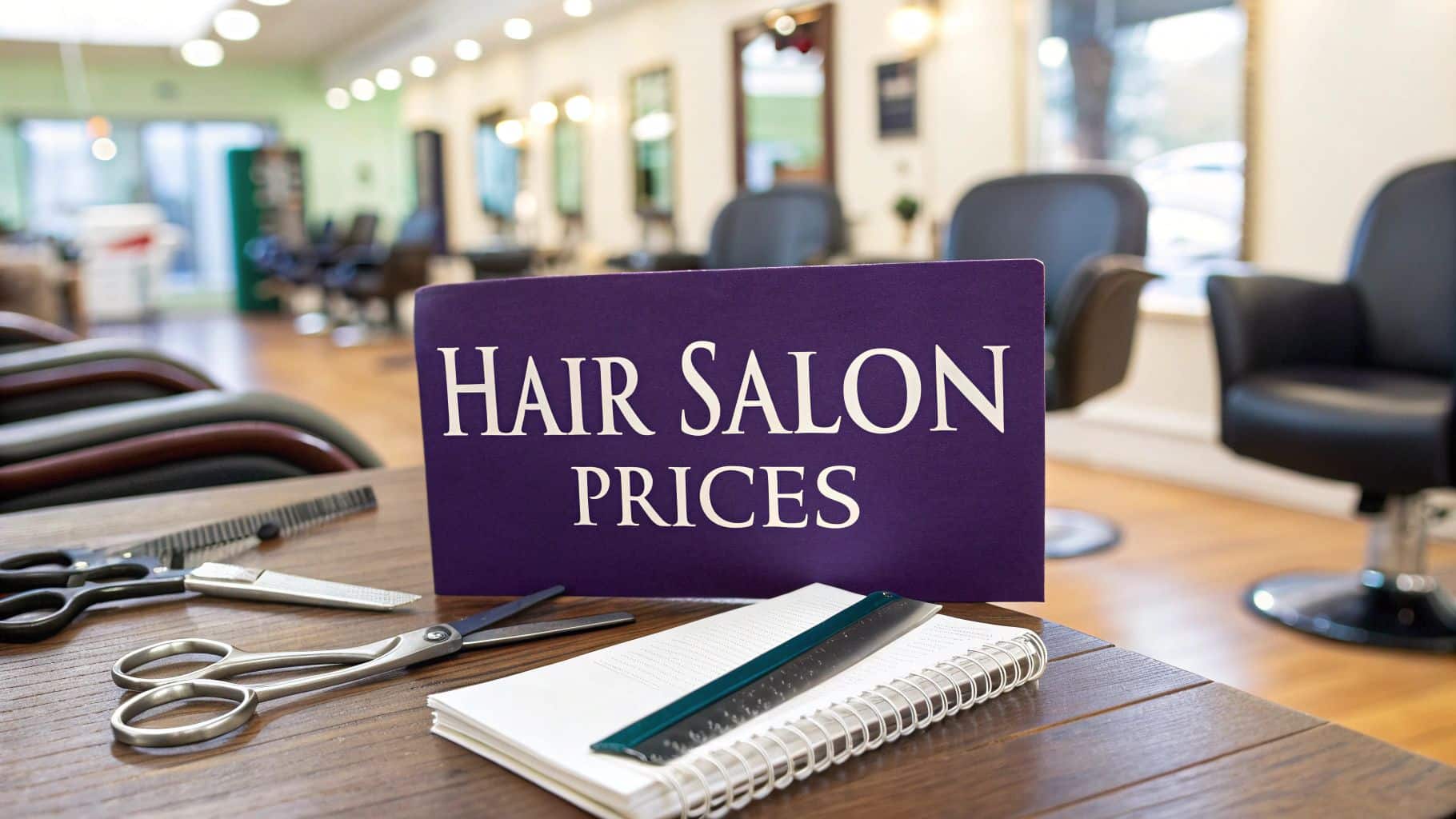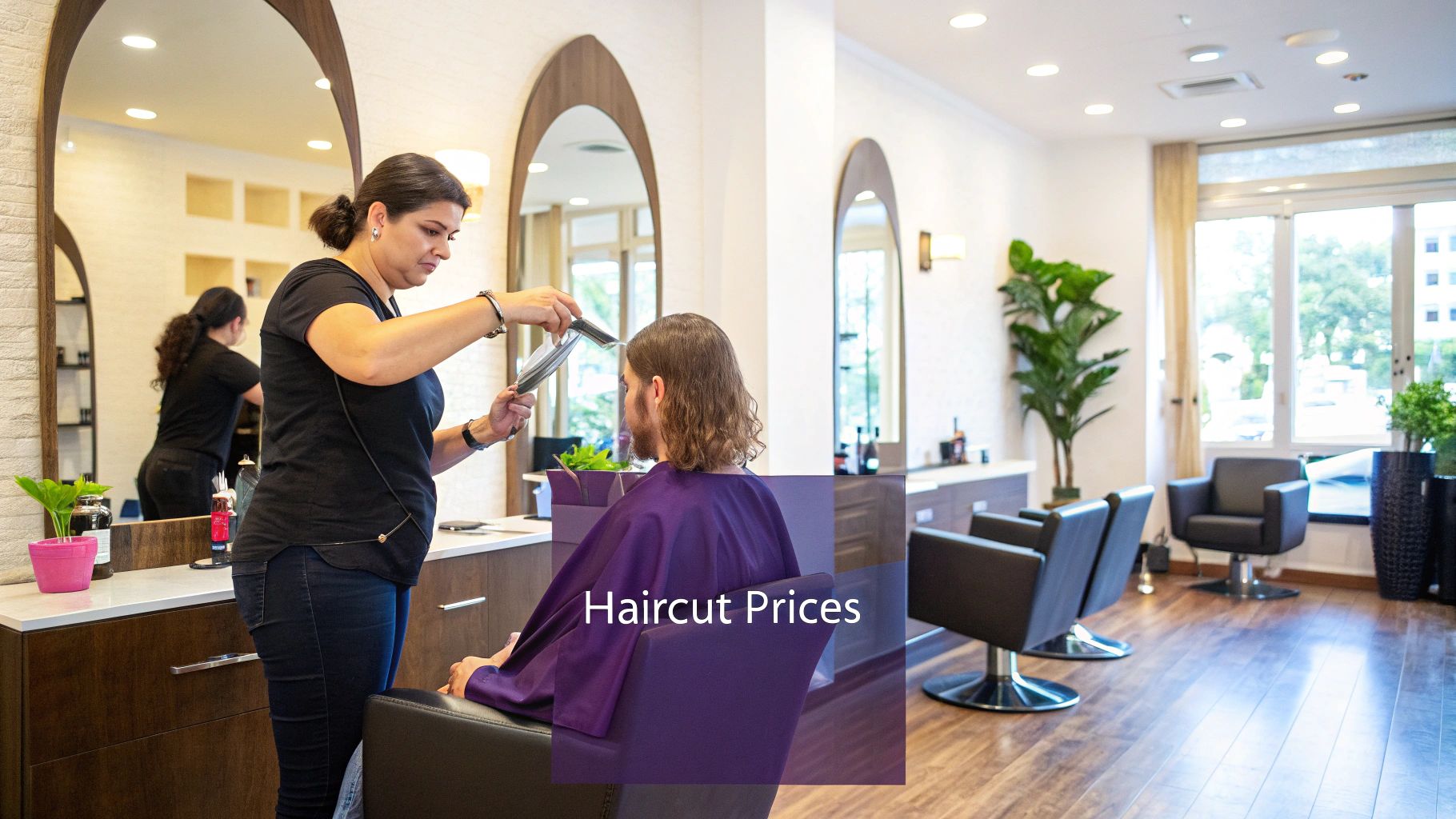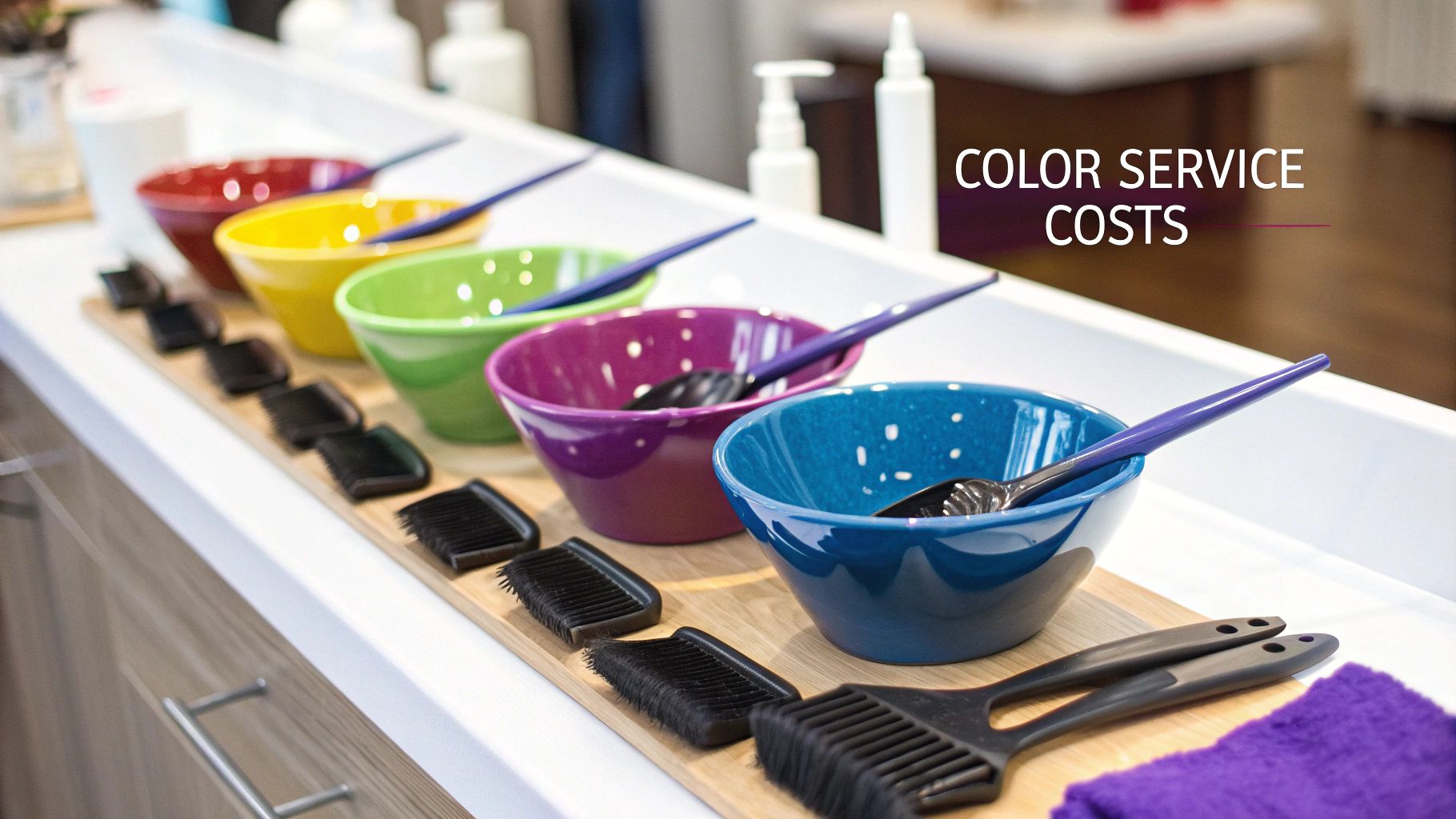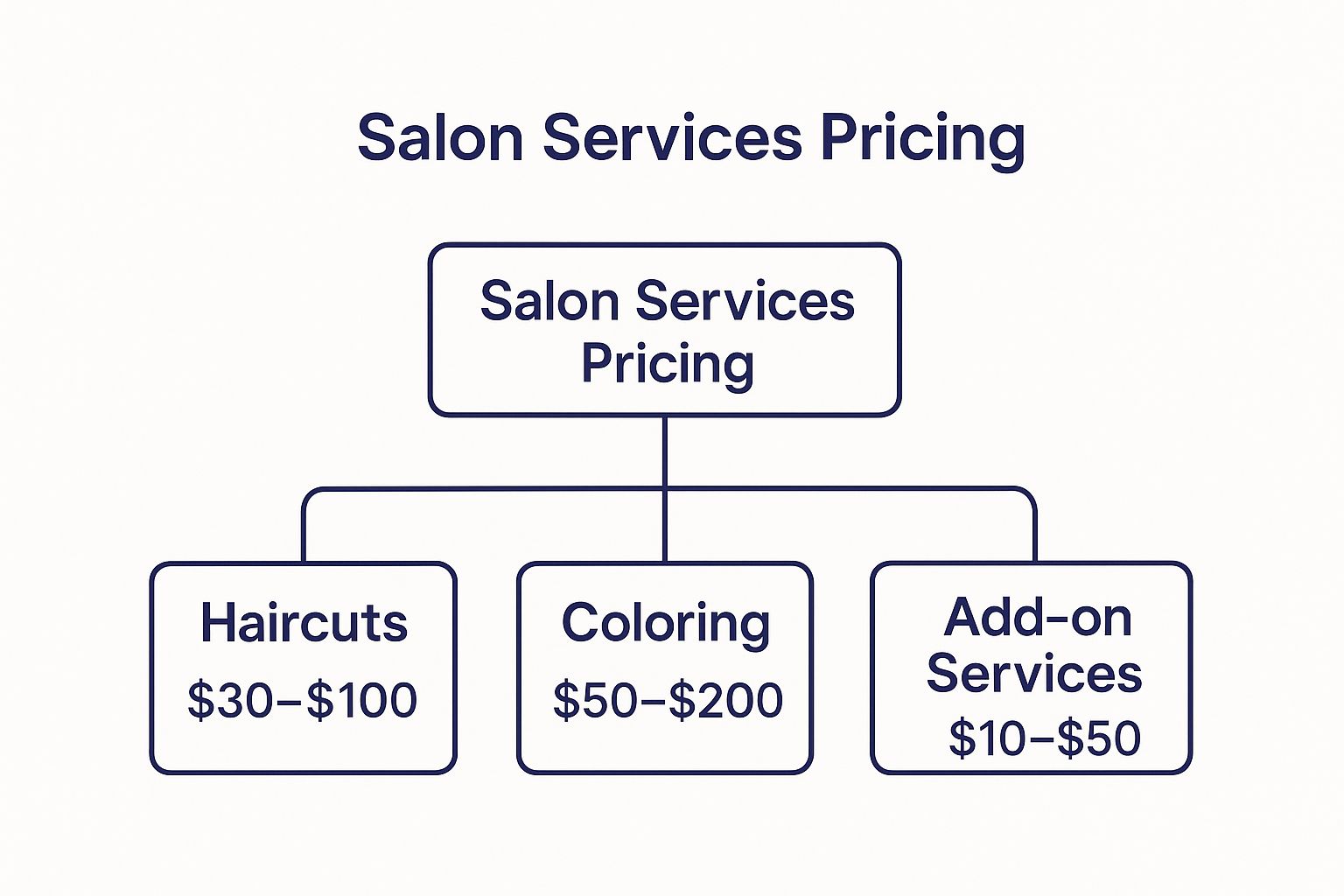Hair Salon Prices Explained for Owners and Clients

The final price on a salon menu isn't just a number—it’s a story of artistry, location, and the real costs of running a business. A basic haircut can swing wildly from $40 to over $150, and figuring out why is the key to everything, whether you're a client searching for a fair price or a salon owner trying to set competitive rates.
Why Hair Salon Prices Vary So Much
Ever left a salon wondering if you paid too much? Or maybe you’ve hesitated to book an appointment because the prices just felt out of reach. You're definitely not alone. The world of salon pricing can feel like a mystery, but once you pull back the curtain, it all starts to make sense.
Think of it like a restaurant menu. A burger at a fast-food joint and a burger at a fancy gastropub are both, well, burgers. But the price difference reflects the chef's skill, the quality of the ingredients, and the overall dining experience. Salons work the same way. The price tag is a reflection of value, not just the service itself.
A huge piece of the puzzle is the stylist's background. A master stylist who has spent a decade honing their craft and investing in advanced color theory classes is naturally going to charge more than a junior stylist fresh out of beauty school. You're paying for their expertise, their eye, and their ability to deliver consistent, high-quality results.
Key Factors at a Glance
A few core elements come together to build that final price you see on the service list. Each one adds a layer of value that justifies the cost. Here's what's going on behind the scenes:
- Location and Overhead: Rent in a trendy downtown district is worlds away from the cost of a space in a quiet suburb. That overhead—rent, utilities, insurance—gets baked directly into the service prices.
- Stylist Expertise: It's all about skill level. A stylist's years in the game, their commitment to ongoing education, and their reputation in the community all influence their pricing tier.
- Product Quality: There's a big difference between bulk, generic color and premium, professional-grade product lines. Top-shelf products cost more upfront, but they deliver far better results and protect the health of your hair.
- Service Complexity: This one's pretty straightforward. A quick trim that takes 30 minutes requires less time and skill than a complex, multi-hour balayage or a tricky corrective color session.
To give you a clearer picture, here's a quick look at what you can generally expect to pay for common services across the U.S.
Average Price Ranges for Common Hair Services
This table gives you a snapshot of typical price ranges for popular hair services in the U.S. Keep in mind, these numbers can shift quite a bit depending on the salon's prestige and, of course, where it's located.
| Service | Average Low-End Price | Average Mid-Range Price | Average High-End Price |
|---|---|---|---|
| Women's Haircut | $40 – $65 | $65 – $100 | $100 – $250+ |
| Men's Haircut | $25 – $40 | $40 – $60 | $60 – $120+ |
| All-Over Color | $70 – $100 | $100 – $150 | $150 – $400+ |
| Full Highlights | $100 – $150 | $150 – $250 | $250 – $500+ |
| Balayage/Ombré | $150 – $200 | $200 – $350 | $350 – $600+ |
As you can see, the range is pretty wide. A haircut in a small town will likely fall on the lower end, while that same service from a top stylist in a major city like New York or Los Angeles will command a premium.

How Market Trends Impact Your Bottom Line
Your salon’s pricing strategy doesn’t just come out of thin air. It’s directly shaped by powerful market forces, both on a global scale and right in your own neighborhood. Getting a handle on these trends is like having a roadmap; it helps you navigate the competitive landscape and set hair salon prices that actually build a profitable, growing business.

The global beauty industry isn’t just growing—it’s absolutely booming. This explosion creates a ripple effect that touches every single salon owner. More competition means you have to work harder to stand out, while a constant stream of new products and techniques means you’re always investing in education and stocking your shelves.
These global shifts directly feed into your operating costs and what clients are willing to pay for the latest styles.
And this growth is no joke. The global salon hair care market is projected to soar from around USD 203.78 billion in 2025 to USD 341.67 billion by 2032. That’s a compound annual growth rate (CAGR) of 7.66%, a huge jump driven by the high demand for styling services. You can discover more insights about the beauty salon market size and see how it affects your business.
From Global Forces to Local Realities
While global trends set the stage, your local market is where the pricing rubber meets the road. The economic health of your city or town plays a massive role. If you're in an affluent area with high disposable income, you can command premium prices. But in a more budget-conscious community, your pricing needs to be more accessible to keep clients coming back.
Market saturation is another killer factor. Are you the only high-end salon in a five-mile radius, or are you one of ten all fighting for the same clients? The more crowded the market, the more pressure you’ll feel to compete on price.
Key Takeaway: Your pricing sweet spot is where broad industry trends meet the specific economic vibe of your local area. Ignore either one, and you risk being too expensive for your neighborhood or way too cheap for the value you provide.
Running a Competitive Analysis
To really thrive, you need to know exactly where you stand. A competitive analysis isn't about copying what the salon down the street is doing; it’s about understanding the landscape so you can strategically position yourself.
Here’s a simple, actionable plan to get started:
- Step 1: Identify Your Top 3-5 Local Competitors: Look for salons that target the same type of client as you. Don't just look at who's physically closest; consider those with a similar brand vibe, service menu, and online buzz.
- Step 2: Analyze Their Service Menus and Pricing: Create a simple spreadsheet and track their prices for key services like haircuts, all-over color, and balayage. Pay close attention to what's included—does their price cover a blow-dry, toner, or conditioning treatment?
- Step 3: Evaluate Their Brand Positioning: How do they market themselves? Are they a luxury retreat, a family-friendly spot, or an edgy, trend-setting studio? Their branding is what justifies their price point. Sift through their website, social media, and client reviews to understand the experience they’re promising.
- Step 4: Find Your Unique Value Proposition: With all this information, you can pinpoint what makes your salon different. Is it your master colorist’s advanced certifications? Your commitment to exclusive, sustainable products? This unique value is your leverage to set prices with confidence, instead of just reacting to what everyone else is doing.
The Core Factors Driving Your Service Prices
Setting your salon prices can feel like a high-stakes puzzle. It’s so much more than just picking numbers that sound right; it's about striking the perfect balance between what your services actually cost to deliver and the incredible value you provide. To really nail your pricing strategy, you have to get under the hood and understand what goes into every single service.
Think of it this way: a master chef and a line cook both use the same basic ingredients, but the chef’s years of experience, creative flair, and solid reputation mean their dishes command a much higher price. The same thing happens in your salon. The final price a client pays is a blend of skill, time, top-notch products, and all the essential costs of running the business.
Stylist Expertise and Experience
Let's be real—the biggest variable in your pricing is the person holding the scissors. A stylist's skill level has a direct line to the quality of the service and how happy that client is when they walk out the door. You aren't just charging for a haircut; you're charging for years of training, advanced certifications, and a sharp artistic eye.
A senior stylist with a decade of experience and a fully booked schedule offers a completely different level of value than a talented but new junior stylist. Recognizing this difference is the key to creating a fair and logical pricing menu.
An actionable way to implement this is with a tiered pricing model. This approach lets you offer services at different price points based on your team's experience, giving clients options while ensuring your stylists are compensated fairly for their expertise.
- New Talent/Junior Stylist: Offers foundational services at an accessible, entry-level price. This is perfect for attracting new clients or those on a budget.
- Senior Stylist: Brings several years of experience and a proven track record. Their prices reflect a higher level of skill and consistency.
- Master Stylist/Director: Has advanced skills, specialized training, and a rock-solid reputation. Their premium pricing is justified by their expertise and high demand.
Salon Overhead and Operational Costs
Your salon's physical space and daily operating costs are the silent partners in every single service you offer. These are the non-negotiable expenses required to keep the lights on, the music playing, and the environment professional and welcoming for your clients.
These costs go way beyond just rent. You must factor in utilities, insurance, salon software subscriptions, marketing spend, and even what it costs to get a new client in the door. Understanding your customer acquisition cost is a huge piece of the puzzle. Using a customer acquisition cost calculator can help you put a real number to this metric, ensuring your prices are actually supporting your growth. Every dollar spent on operations needs to be accounted for in your service menu.
For a deeper look, you can explore detailed breakdowns of common beauty salon profit margins to see how all these costs fit into the bigger financial picture. https://gohappybeauty.com/beauty-salon-profit-margins/
Product Quality and Service Complexity
Finally, the tangible stuff—the actual products and time—plays a massive role. The quality of the products you use, from that premium Italian color line to the luxury styling creams, directly impacts the final look and how long it lasts. Higher-quality products come with a higher price tag, and that has to be reflected on your menu.
On top of that, you have to consider the time and complexity of the service itself. A simple trim is a world away from a multi-hour corrective color or a full head of extensions. Your pricing has to accurately reflect the time, skill, and amount of product each unique service demands.
This breakdown shows just how different service categories contribute to your pricing structure.

You can see how foundational services like haircuts sit at a lower price range, while the more complex and time-intensive services like coloring rightfully command a higher premium.
Pricing for a Modern and Tech-Savvy Salon
Let's be real: in a world where clients can order a coffee, book a flight, and schedule a doctor's appointment from their phone, they expect the same convenience from their salon. Your salon’s technology and trend-awareness aren't just fancy extras anymore—they're powerful tools that build value. When you integrate modern solutions and cater to what clients actually want, you're not just offering a service; you're creating an experience that justifies premium hair salon prices.

Think beyond the chair. The client experience starts long before they arrive. A slick online booking system that zaps out appointment reminders, digital consultation forms that cut down on paperwork, or even AI tools that let them visualize a new color—all of this adds serious value.
These features scream professionalism and show you respect your client's time. That seamless, personalized feeling is exactly what makes a higher price point feel not just fair, but totally worth it.
Using Technology to Boost Perceived Value
Technology isn't just about making your life easier behind the scenes; it's a visible signal that your salon is modern and professional. When clients see you've invested in top-tier tools, it instantly elevates their perception of your brand, making them more comfortable with premium pricing.
For example, high-quality salon management software does more than just organize your schedule. It elevates the entire client journey. If you're ready to make that leap, our guide on the 12 best hair salon software options can point you in the right direction. It’s an investment that pays for itself by creating a smoother, more professional vibe that clients will happily pay more for.
Tapping Into the Demand for Conscious Beauty
Beyond the digital upgrades, what your clients believe in is also shaping modern pricing. The massive shift toward clean, sustainable, and organic beauty isn't just a trend; it's a market force. Savvy salon owners are tapping into this by aligning their services with these values.
Clients are more than willing to pay a premium for products and services that match their ethical and wellness-focused lifestyles.
Actionable Tip: Stock high-performance, eco-friendly product lines and actively promote your commitment to clean beauty on your website and social media. This does more than just attract a specific clientele; it positions your salon as a premium destination, allowing you to charge accordingly.
This isn't a niche market, either. The U.S. beauty market, which is the largest in the world, is projected to hit USD 91.23 billion by 2025. A huge chunk of that growth is fueled by people seeking out specialized services like clean and organic treatments. This tells you there's a massive opportunity waiting for salons that get on board.
Ultimately, weaving technology and conscious consumerism into your business does more than just modernize your salon. It fundamentally jacks up the value of your services, giving you the power to set prices that truly reflect the top-tier experience you provide.
Building Your Salon's Profitable Pricing Strategy
Alright, let's move from theory to action. This is where you build a pricing model that ensures your salon thrives. Crafting a price list that feels right is one thing, but building one that guarantees profitability is a different ball game. Follow these actionable steps to create a pricing strategy grounded in solid business sense—not just what the salon down the street is doing.
Think of it like building a house. You wouldn't just start throwing up walls without a blueprint. Your pricing needs that same solid foundation, built on a crystal-clear understanding of your costs, your value, and your goals.
Step 1: Calculate Your Break-Even Point
Before you can think about profit, you must know your break-even point—the absolute minimum you need to make to cover every single expense without making or losing a dollar. This is your baseline and the non-negotiable starting point for every service on your menu.
To find it, you have to tally up all your costs:
- Fixed Costs: List all the bills that show up every month—rent, insurance, salaries, and software subscriptions.
- Variable Costs: Track the costs that change with how busy you are, such as product usage (color, shampoo), utilities, and stylist commissions.
Once you know your total cost to operate per hour, you can determine the minimum price for any service based on how long it takes. Every dollar you charge above that number is pure profit margin.
Step 2: Implement Smart Pricing Models
A one-size-fits-all menu is a surefire way to leave money on the table. Adopting strategic pricing models allows you to cater to a wider range of clients while maximizing your revenue.
A fantastic place to start is with tiered pricing based on stylist experience. This model is a win-win: clients can choose a price point that fits their budget, and you can fairly compensate your senior team for their advanced skills. For some great inspiration on how to lay this out, check out some examples of a well-organized salon price list.
Another powerful tactic is service bundling. Combine a popular service like a haircut with an add-on like a deep conditioning treatment or a gloss, then offer the package at a slight discount. This encourages clients to try new services and increases the average ticket price per visit.
To truly build a profitable pricing strategy, salon owners should explore concepts like revenue optimization, which involves using data to forecast demand and set prices effectively. Mastering these revenue optimization strategies can transform your financial outlook.
Step 3: Ground Your Prices in Industry Benchmarks
You shouldn't blindly copy your competitors, but you absolutely must know where you stand in the market. Use industry benchmarks as a reality check to ensure your prices are competitive without undercutting your profit.
On average, a U.S. salon pulls in about $245,000 in annual revenue, with profit margins typically hovering around 8.2%. Salon owners themselves often earn between $115,000 and $215,000 a year, which shows that a well-run business can be incredibly rewarding, even with tight competition. Knowing this data helps you set realistic financial goals and build a pricing strategy that ensures your salon’s long-term health and success.
Got Questions About Salon Pricing? We’ve Got Answers.
Let's be real: figuring out hair salon prices can feel like a maze for everyone. Clients are left wondering what's fair, and new salon owners are trying to nail down rates that keep the lights on and the clients happy.
Think of this as your no-fluff guide to salon finances. We're cutting through the noise to give you the clarity you need, whether you're budgeting for your next balayage or building your salon's bottom line.
Why Do Hair Salon Prices Change So Much Between Locations?
Ever wonder why a haircut in a downtown high-rise costs double what it does in a quiet suburb? It really boils down to three big things.
First up is overhead. That chic salon in a prime downtown spot has sky-high rent and operating costs compared to a smaller studio on a less busy street. Those expenses have to be baked into the service prices.
Next is the stylist's expertise. A master stylist with two decades of experience and a wall of advanced certifications is going to charge more than a junior stylist who’s still honing their craft. You're paying for their years of skill and education.
Finally, it’s about the overall experience. From the luxe, high-end products they use to the relaxing, Instagram-worthy ambiance, every detail adds to the value—and the final bill.
How Do I Set Competitive Prices for My New Salon?
Setting your prices isn't about throwing a dart at a board. You need a solid strategy. Start by calculating your baseline cost for every single service—that means factoring in your share of rent, supplies, salaries, and utilities. This number is your absolute break-even point.
From there, scope out your local competition to get a feel for the market rate. But don't just copy their menu! Instead, figure out what makes you special.
Here’s a simple game plan:
- Define Your Brand: Are you a luxury salon using premium organic products? A budget-friendly spot for the whole family? Or a trend-focused studio for the fashion-forward? Your prices must align with your brand identity.
- Use Tiered Pricing: A tiered model based on stylist experience is a fantastic way to offer options for different budgets while also creating a clear career path for your team.
- Communicate Your Value: This is the most important part. Clearly explain the "why" behind your prices during consultations, on your website, and in your marketing. When clients understand the expertise, quality products, and experience they're paying for, they are happy to invest.
Is Tipping Expected and How Much Should I Tip?
Yep, tipping is standard practice in the salon world and a huge part of a stylist's income. Think of it like dining out at a restaurant—the industry norm is 15-20% of the total service cost. If you're absolutely thrilled with your new look, tipping a little extra is a fantastic way to show your appreciation.
And don't forget the salon assistant who gave you that amazing shampoo or helped with your color! A tip of around $3-$5 is a common and thoughtful way to acknowledge their hard work.
What’s Usually Included in a Haircut or Color Service?
While it can vary a bit from salon to salon, some things are pretty standard. A haircut price typically covers the initial consultation, a relaxing shampoo and conditioning treatment, the cut itself, and a basic blow-dry to finish things off.
A standard color service generally includes the consultation and the color application.
Quick heads-up: extra services like deep conditioning treatments, glosses, toners, or complex styling (like a fancy updo) are often considered add-ons and will cost extra. The best way to avoid surprises at the checkout counter is to ask your stylist during the consultation exactly what's included in the price.
Ready to build a stunning website that showcases your unique value and helps you attract your ideal clients? gohappybeauty provides beautiful, SEO-optimized websites designed specifically for beauty professionals like you. Start building your dream salon website today!
Grow your beauty business
Our focus is, and always will be, helping you improve your online presence and generate more business from your website. That is what we do, for you.

